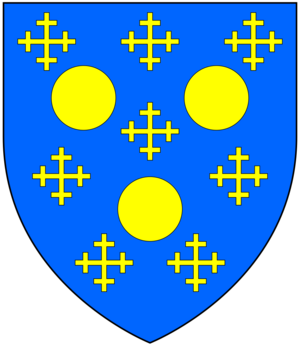William Coffin (courtier) facts for kids

Sir William Coffin (born around 1492 – died December 8, 1538) was an important person who worked for King Henry VIII of England. He was a trusted helper to the King and also looked after the horses for Queen Jane Seymour. In 1529, he was chosen to be a Member of Parliament (MP) for Derbyshire.
Contents
Early Life and Family
Sir William Coffin was born around 1495. His family lived at a place called Portledge in Alwington, North Devon. He was the younger son of Richard Coffin (1456–1523). His father was the Sheriff of Devon in 1510. Sir William's mother was Alice Gambon.
Working for the King
Sir William Coffin lived during the time of King Henry VIII. He was often at the King's court. Around 1515, he joined the King's household. He became a courtier, which means he was a trusted helper to the King. He was also a Gentleman of the Privy Chamber. This was a very important job.
There were about 40 Gentlemen of the Privy Chamber. Their job was to help the King in public and in private. They were all important knights or esquires. Two of them had to be at each meal to serve the King. They also had to sleep close to the King at night.
In 1519, Sir William Coffin joined King Henry at a big event. It was a tournament called the Field of the Cloth of Gold. He was one of the King's eighteen favorite people there.
Sir William continued to serve the King even after Anne Boleyn was no longer Queen. He also served the King's third wife, Queen Jane Seymour.
Public Service and Knighthood
In 1529, Sir William was chosen as an MP for Derbyshire. He had connections to that area because of his marriage. In 1531, he became the High Sheriff for Derbyshire and Nottinghamshire.
He was in charge of the horses at the crowning ceremony of Anne Boleyn in 1533. During this time, the King made him a knight. This meant he was now called "Sir" William Coffin.
A historian named Eric Ives said that Coffin was a "professional household administrator." This means he was very good at managing the King's household. He also helped Queen Jane Seymour in the same way.
Marriage and Family Life
William Coffin married Margaret Dymoke. She was the daughter of Sir Robert Dymoke. Her family had a special role as the King's Champion. Margaret was also the sister of Sir Edward Dymoke.
Before marrying Sir William, Margaret was married to Sir Richard Vernon. He died in 1517. When she became a wealthy widow, King Henry VIII encouraged her to marry Sir William Coffin.
Margaret had also been at the Field of the Cloth of Gold in 1519. She was there with Catalina of Aragon, the King's first wife. Margaret and Sir William Coffin knew each other from the court.
Margaret was one of the ladies who waited on Anne Boleyn in the Tower of London. In Queen Jane Seymour's household, Margaret was a Lady of the Bedchamber.
Sir William Coffin died in December 1538. Shortly after his death, Margaret married Sir Richard Manners. Sir William Coffin did not have any children.
Death and Legacy
Sir William Coffin died suddenly on December 8, 1538. He passed away in Standon, Hertfordshire. He made his will on the very day he died. He was buried in the middle of the church in Standon. His memorial stone is still there.
Since Sir William Coffin had no children, his lands went to his nephews. He left most of his belongings to his wife. His properties in Derbyshire were left to two of his servants.

